
Menulis kes ujian ialah kemahiran asas untuk memastikan kebolehpercayaan dan keteguhan kod anda. Kes ujian boleh membantu mengenal pasti pepijat dan mengesahkan bahawa kod berfungsi seperti yang dimaksudkan.
Kes ujian boleh ditulis menggunakan mana-mana bahasa pengaturcaraan seperti Java, Python, C# dan banyak lagi. Walau bagaimanapun, ramai penguji lebih suka menulis kes ujian di Java kerana sokongan komuniti yang kukuh dan penjajaran dengan keperluan projek. Mengautomasikan kes ujian ini dalam Java membantu penguji menjimatkan masa pelaksanaan dan menangkap ralat pada peringkat awal ujian.
Java ialah salah satu bahasa pengaturcaraan yang paling banyak digunakan untuk ujian automasi. Menulis kes ujian dalam Java bermakna membina keseluruhan projek automasi yang mengikuti dan melaksanakan konsep OOP. Ini menjadikan projek dan kes ujian lebih mantap, dan keseluruhan kod dikategorikan kepada banyak kelas dan kaedah, menjadikannya lebih boleh diselenggara dan mudah digunakan.
Kes ujian automatik membantu menguji ciri dengan cepat sekiranya berlaku regresi dan membantu menjimatkan banyak usaha manual. Kes ujian ini melaksanakan beberapa aliran pada halaman web dan kemudian menggunakan penegasan untuk mengesahkan sama ada output sepadan dengan output yang dikehendaki.
Sebagai contoh, Untuk bahagian Dua Medan Input pada halaman LambdaTest Selenium Playground, beberapa kes ujian akan kelihatan seperti di bawah:



Semasa menulis kes ujian dalam Java, beberapa perkara perlu dipertimbangkan, seperti aliran ujian, skop ujian, penamaan, penegasan, data ujian, pengelompokan, pengesanan WebElements, dll. Apabila digunakan dengan tepat, semua ini menghasilkan ujian yang baik kes yang mudah difahami dan diselenggara pada masa hadapan apabila lebih banyak perubahan datang.
Walau bagaimanapun, tindakan awal untuk bermula dengan aliran ujian adalah untuk mencari WebElement yang mana anda mesti menulis kes ujian yang berkesan dalam Java.
Perkara lain untuk belajar tentang menulis kes ujian dalam Java ialah mencari WebElements. Ini diperlukan kerana aliran kes ujian akan berinteraksi dengan WebElements ini untuk melakukan tindakan seperti memasukkan data, mengklik butang, mendapatkan semula data, dsb., untuk mendapatkan keputusan. Terdapat pelbagai cara untuk mencari pencari WebElement dalam Selenium, seperti ID, Nama, CSS, XPath, linkText, dsb.
Sebelum menunjukkan cara menulis kes ujian dalam Java, mari pelajari cara WebElements berbeza yang digunakan dalam aliran ujian boleh dikesan menggunakan strategi pengesan mereka. Kami akan menggunakan XPath atau ID pencari untuk mencari semua WebElements untuk kes ujian ini.
Anda boleh menggunakan salah satu kaedah yang paling biasa untuk mencari elemen, iaitu, findElement() dalam Selenium.

driver.findElement(By.xpath("//*[contains(text(),'Two')]"));
driver.findElement(By.xpath("//*[contains(text(),'first value')]"));
driver.findElement(By.xpath("//*[contains(text(),'first value')]"));
driver.findElement(By.xpath("//*[contains(text(),'Sum')]"));
driver.findElement(By.id("sum1"));
driver.findElement(By.id("sum2"));
driver.findElement(By.id("user-message"));
driver.findElement(By.id("addmessage"));
Anda juga boleh merujuk kepada panduan pencari Selenium ini untuk mengetahui cara mencari WebElements semasa menulis kes ujian dalam Java.

Sebelum menulis kes ujian yang berkesan dalam Java, anda mesti menyediakan projek dengan semua perpustakaan dan alatan yang diperlukan. Kami akan menggunakan Eclipse IDE untuk menunjukkan persediaan untuk projek Maven. Selain itu, kami akan menambah TestNG sebagai rangka kerja ujian untuk mengendalikan pelaksanaan ujian dan melaksanakan kaedah persediaan dan teardown.
Dalam demonstrasi ini, pada mulanya kami akan menulis 3 kes ujian untuk merangkumi semua kes ujian dalam Java yang dinyatakan dan melaksanakan semua amalan terbaik yang berkenaan.
Senario Ujian 1:
Navigasi ke bahagian Dua Medan Input di Taman Permainan Selenium (Demo Borang Mudah)
Tegaskan semua Elemen Web bahagian ini untuk keterlihatan
Kenal pasti pencari untuk label Dua Medan Input.
Kenal pasti pencari untuk label nilai **pertama **dan **kedua.
Kenal pasti pencari untuk kotak input nilai **pertama **dan **kedua.
Kenal pasti pencari untuk butang Dapatkan Jumlah.
Hasil label.
Senario Ujian 2 :
Navigasi ke bahagian Dua Medan Input pada halaman Selenium Playgrounds (Simple Form Demo).
Masukkan nilai yang sah dalam kedua-dua kotak input.
Klik pada butang Dapatkan Jumlah.
Tegaskan jumlahnya betul dan dipaparkan di bawah label **Hasil **.
Senario Ujian 3 :
Navigasi ke bahagian Dua Medan Input pada halaman Selenium Playgrounds (Simple Form Demo).
Masukkan nilai dalam mana-mana kotak input.
Klik pada butang Dapatkan Jumlah.
Mesej ralat menegaskan dipaparkan di bawah label Hasil.
Mari mula memasang perpustakaan yang diperlukan kerana kami mempunyai aliran ujian dan bersedia untuk menggunakan alatan dan perpustakaan.
Persediaan Projek:
Seperti yang dinyatakan, kami akan menggunakan Eclipse IDE untuk menulis kes ujian dalam Java. Walau bagaimanapun, anda boleh menggunakan mana-mana IDE untuk menulis kes ujian. Anda hanya perlu mencipta projek Maven baharu.
Lancarkan Eclipse IDE dan buka wizard Projek Baharu dengan mengklik Fail > Baharu > Projek.
Di bawah Wizards, kembangkan Maven, pilih Projek Maven, dan klik Seterusnya.
Klik pada kotak semak Buat projek mudah dan klik pada Seterusnya.
Pada wizard Projek Maven Baharu ini, masukkan Id Kumpulan dan Id Artifak dan klik pada Selesai untuk mencipta projek anda. Di sini, Group Id ialah nama unik yang membantu mengenal pasti satu kumpulan projek daripada kumpulan lain, dan Artifact Id ialah nama unik yang diberikan kepada projek yang akan kami buat.
Setelah projek dibuat, struktur projek akan menyertakan fail pom.xml dalam folder akar. Di sini, kami akan menambah kebergantungan yang diperlukan untuk menulis dan melaksanakan kes ujian automasi di Java. Kami akan menambah pergantungannya kerana kami akan menggunakan TestNG sebagai rangka kerja ujian. Selain itu, kami akan menambah kebergantungan Selenium, kerana kes ujian yang akan kami tulis melibatkan automasi web.
You can fetch the latest TestNG and Selenium dependencies from the Maven Repository.
The updated pom.xml would look like the one below.
<project xmlns="http://maven.apache.org/POM/4.0.0"
xmlns:xsi="http://www.w3.org/2001/XMLSchema-instance"
xsi:schemaLocation="http://maven.apache.org/POM/4.0.0 https://maven.apache.org/xsd/maven-4.0.0.xsd">
<modelVersion>4.0.0</modelVersion>
<groupId>demo.lambdaTest</groupId>
<artifactId>JavaTestCase</artifactId>
<version>0.0.1-SNAPSHOT</version>
<dependencies>
<dependency>
<groupId>org.testng</groupId>
<artifactId>testng</artifactId>
<version>7.10.1</version>
<scope>test</scope>
</dependency>
<dependency>
<groupId>org.seleniumhq.selenium</groupId>
<artifactId>selenium-java</artifactId>
<version>4.21.0</version>
</dependency>
</dependencies>
</project>
The next step is to add the test class files where we will write the test case in Java. Add 2 Java class files under src/test/java package.
BaseTest.java: This file will have the setup() and tearDown() methods to create and remove the *WebDriver *instances for test cases.
**TwoInputFieldTests.java: **This file will be the test class file where all the test cases discussed above will be written.
The completed BaseTest.java would look like the one below.
package LocalGrid;
import org.openqa.selenium.WebDriver;
import org.openqa.selenium.chrome.ChromeDriver;
import org.testng.annotations.*;
public class BaseTest {
public static WebDriver driver;
@BeforeMethod
public void setup()
{
driver = new ChromeDriver();
System.out.println("Navigating to Two Input Field section");
driver.get("https://www.lambdatest.com/selenium-playground/simple-form-demo");
}
@AfterMethod
public void tearDown()
{
driver.quit();
}
}
Code Walkthrough:
Below is the complete code walkthrough to understand the code written in the above BaseTest.java file.




With this, the BaseTest file is created, and we are ready to create a test file to run the test case in Java.
Create a file called TwoInputFieldTests.java. This file will contain all the code for the test scenarios discussed earlier.
package LocalGrid;
import org.openqa.selenium.By;
import org.testng.Assert;
import org.testng.annotations.Test;
public class TwoInputFieldTests extends BaseTest
{
@Test(groups = {"uiTest"})
public void shouldVerifyAllElementsWhenThePageIsLoaded()
{
System.out.println("Verify Two Input Fields title is displayed.");
Assert.assertTrue(driver.findElement(By.xpath("//*[contains(text(),'Two')]")).isDisplayed());
System.out.println("Verify enter first value label is displayed.");
Assert.assertTrue(driver.findElement(By.xpath("//*[contains(text(),'first value')]")).isDisplayed());
System.out.println("Verify enter first value textbox is displayed.");
Assert.assertTrue(driver.findElement(By.id("sum1")).isDisplayed());
System.out.println("Verify enter second value label is displayed.");
Assert.assertTrue(driver.findElement(By.xpath("//*[contains(text(),'second value')]")).isDisplayed());
System.out.println("Verify enter second value textbox is displayed.");
Assert.assertTrue(driver.findElement(By.id("sum2")).isDisplayed());
System.out.println("Verify Get Sum button is displayed.");
Assert.assertTrue(driver.findElement(By.xpath("//*[contains(text(),'Sum')]")).isDisplayed());
System.out.println("Verify result label is displayed.");
Assert.assertTrue(driver.findElement(By.id("user-message")).isDisplayed());
}
@Test(groups = {"positiveTest", "sanity"})
public void shouldReturnTheResultWhenBothNumbersAreValid()
{
System.out.println("entering first value");
driver.findElement(By.id("sum1")).sendKeys("5");
System.out.println("entering second value");
driver.findElement(By.id("sum2")).sendKeys("10");
System.out.println("click on sum");
driver.findElement(By.xpath("//*[contains(text(),'Sum')]")).click();
System.out.println("fetch the result and assert it");
String result = driver.findElement(By.id("addmessage")).getText();
Assert.assertEquals(result, "15", "Sum is incorrect. Expected : 15 but Found : " + result);
}
@Test(groups = {"errorTest", "sanity"})
public void shouldShowErrorWhenAnyNumberIsMissing()
{
System.out.println("entering first value");
driver.findElement(By.id("sum1")).sendKeys("5");
System.out.println("click on sum");
driver.findElement(By.xpath("//*[contains(text(),'Sum')]")).click();
System.out.println("fetch the error message and assert it");
String errorMessage = driver.findElement(By.id("addmessage")).getText();
String expectedError = "Entered value is not a number";
Assert.assertEquals(errorMessage, expectedError, "Incorrect error message. Expected : " + expectedError + " but Found : " + errorMessage);
}
}
``
**Code Walkthrough:**
Below is the complete code walkthrough to understand the code written in the above TwoInputFieldTests.java file.
1. Add a new class file as TwoInputFieldTests.java and extend BaseTest. This helps to inherit and access the *driver* variable and methods of the base class in all the test cases and prevents redundant code.

1. Add the first test case as *shouldVerifyAllElementsWhenThePageIsLoaded()* and *annotate* it with the *@Test* annotation. This annotation helps to identify a method as a test case and execute it as a TestNG case. We have used the *groups* attribute of *@Test* annotation here to mark this test as part of the *uiTests* group so that it gets executed whenever these group cases are triggered.

1. In this test case, we verify if all the Two Input Fields section elements are displayed when the web page is loaded.

1. For this, we use the *isDisplayed()* method of WebElement to check whether the element is displayed. This returns a boolean *true* value if the element is displayed and *false* if not.

1. To assert the same, we use the *assertTrue()* method of the *Assert* class. It passes if the passed value is true, meaning the element is displayed.

Assertions are crucial in the automation testing process, ensuring the software functions as expected. To learn assertTrue(), follow this guide on assertTrue() in Java and gain valuable insights.
1. Write a similar assert statement using the *isDisplayed()* method for all the web elements to verify the entire UI of this section.
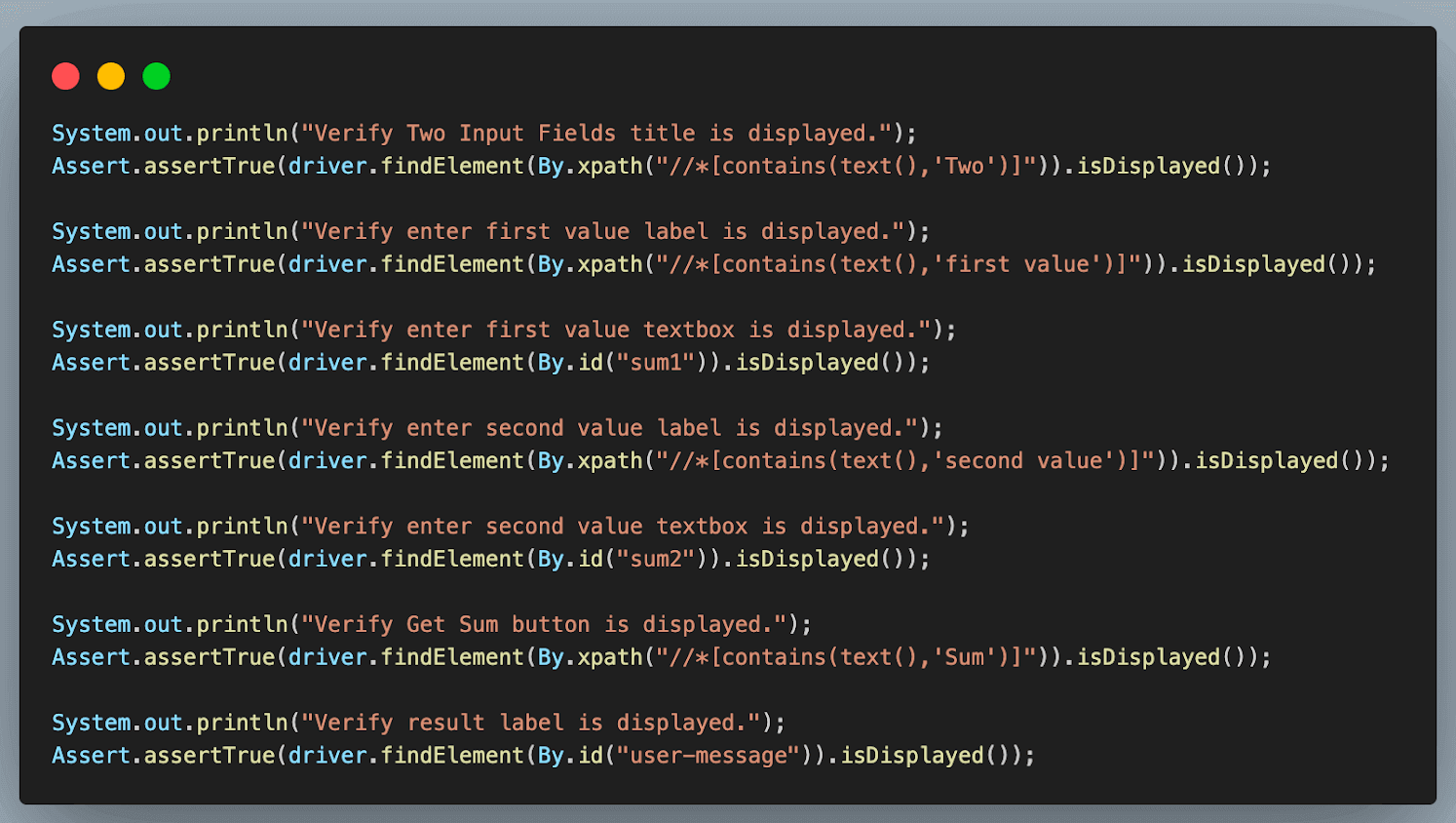
1. Add the second test case as *shouldReturnTheResultWhenBothNumbersAreValid*(). Similar to the previous case, annotate it with the *@Test* annotation and add it to *positiveTest* and *sanity* groups. We have added 2 group names here, unlike 1 in the previous case. This means that this test case in Java will get executed as part of both these groups.

1. Enter the first and second values using the *sendKeys()* method. This method of Selenium WebDriver is used to enter data in any input text box field while working with web automation.
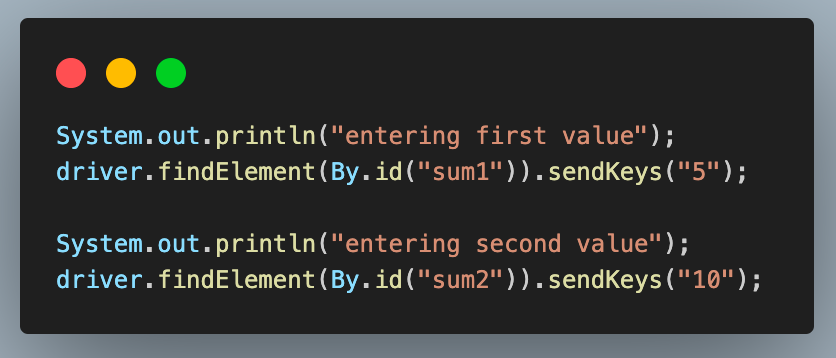
1. After entering the values, click the **Get Sum** button to get the result. For this, another method of WebDriver, *click()* is used.

1. Finally, we fetch the result using the *getText()* method and store it in a variable. This method retrieves any text value from the web page using Selenium web automation. Assert’s a*ssertEquals()* method compares this value with the expected result.

This method is used to compare two values as part of an assertion. Learn how to use asserts in TestNG correctly to help you verify and validate your actual and expected results.
1. Add the last test case and name it as *shouldShowErrorWhenAnyNumberIsMissing()*. Like the previous cases, annotate it with *@Test* and add it to the *negativeTest *and *sanity *groups.

1. Enter any one value using the *sendKeys()* method. Here, we are entering the first value field.

1. Click on the **Get Sum** button.

1. Fetch the error message using the *getText()* method and assert it to be the same as the expected error message using the *assertEquals()* method.

**Test Execution And Results**
Right-click > Select Run As > TestNG, Test to execute the tests individually.

**Result:**
*shouldVerifyAllElementsWhenThePageIsLoaded()*
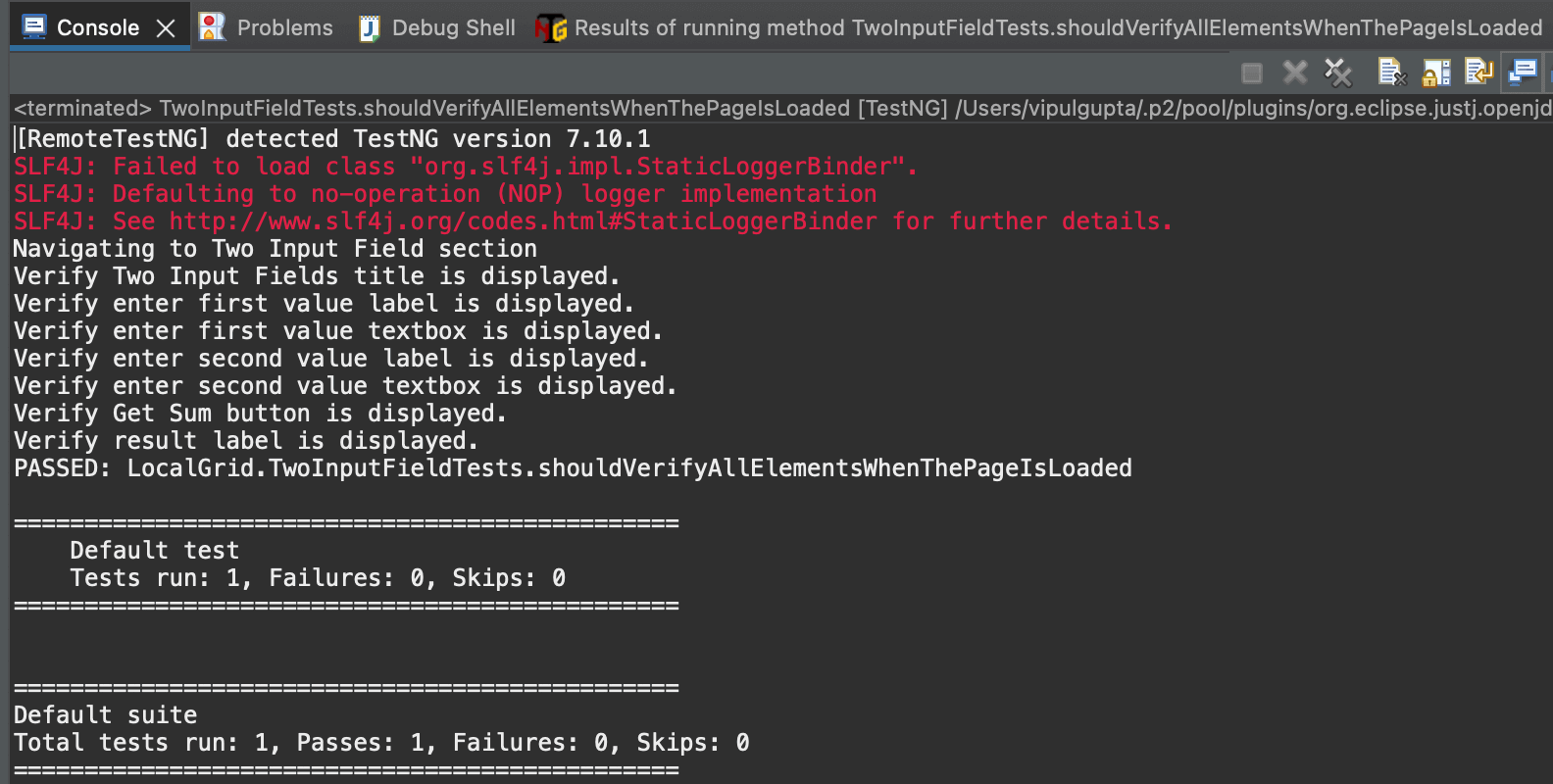
**Result:**
*shouldReturnTheResultWhenBothNumbersAreValid()*
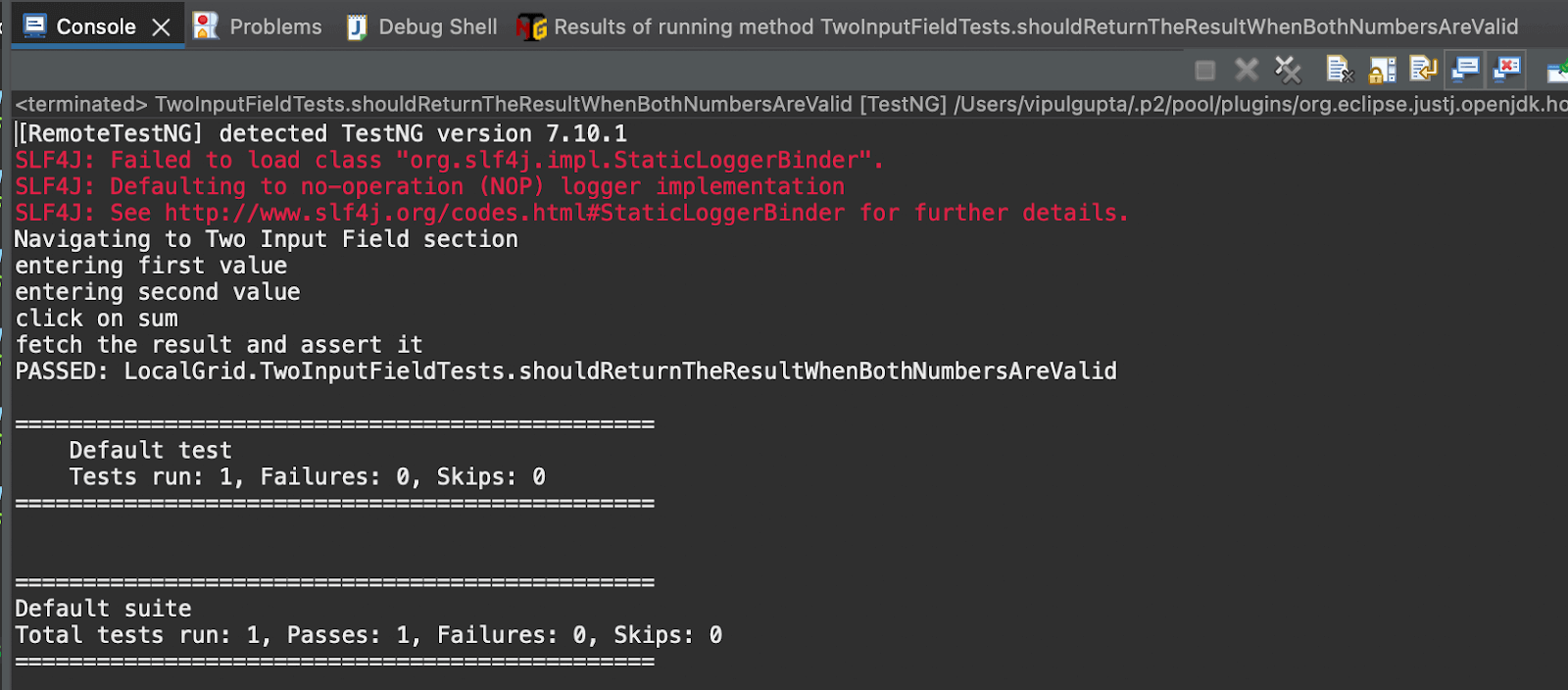
**Result:**
*shouldShowErrorWhenAnyNumberIsMissing()*
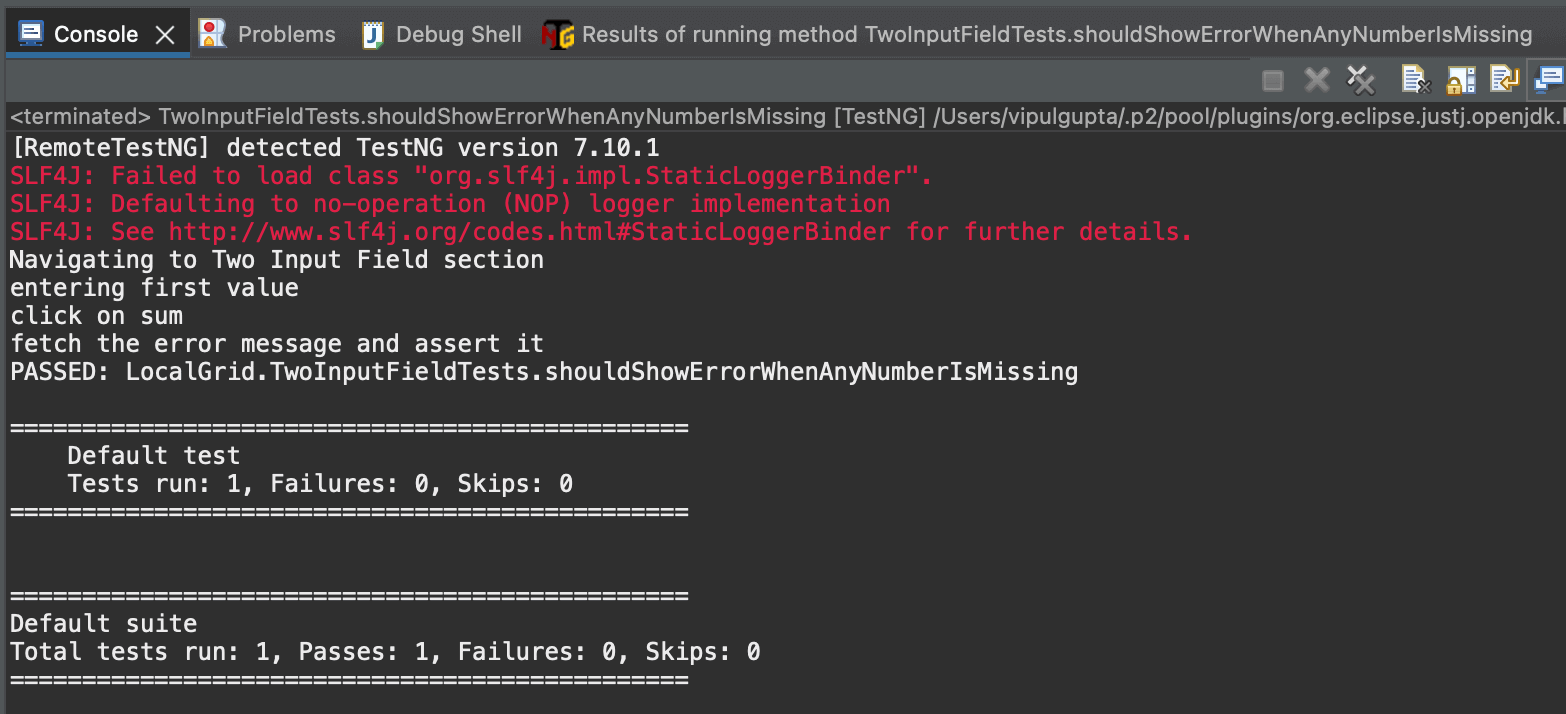
Running tests locally is manageable when working with up to three or four browsers and one operating system. However, this limitation makes it difficult for testers to conduct tests on more than four browsers and multiple operating systems. To address this, testers can use a cloud-based platform where they do not have to worry about maintaining test infrastructure and can conduct comprehensive cross-browser and cross-platform testing seamlessly. One such platform is LambdaTest.
It is an AI-powered test execution platform that lets you run manual and automated [cross-browser testing](https://www.lambdatest.com/cross-browser-testing?utm_source=medium&utm_medium=organic&utm_campaign=aug_12&utm_term=rj&utm_content=blog) at scale, with over 3000+ real devices, browsers, and OS combinations.
This platform provides the speed and resources to make test executions faster and more reliable. It facilitates parallel execution, allowing multiple tests to run simultaneously for large automation suites. This cloud grid platform also offers enhanced logging, maintenance, and debugging resources.
Now, let’s move the local test script to the LambdaTest platform with a few modifications to leverage all the features this cloud grid offers.
## How To Write a Test Case in Java for Cloud Execution?
Having understood the flow of writing and executing the first test case in Java using Selenium and TestNG, let us move ahead and learn how we can do the same on a cloud grid platform.
To use the LambdaTest cloud grid to run the Selenium automation test cases, we need to make some changes to the code to use Selenium *RemoteWebDriver*, which will help connect to the LambdaTest cloud grid and execute the cases over there.
Most of these changes involve configuring the WebDriver settings in BaseTest.java. The modified BaseTest.java with the cloud grid integration will look similar to the example below.
package CLoudGRid;
import java.net.*;
import java.util.HashMap;
import org.openqa.selenium.remote.RemoteWebDriver;
import org.openqa.selenium.chrome.ChromeOptions;
import org.testng.annotations.*;
public class BaseTest {
public RemoteWebDriver driver = null;
String username = System.getenv("LT_USERNAME") == null ? "<lambdatest_username>" : System.getenv("LT_USERNAME");
String accessKey = System.getenv("LT_ACCESS_KEY") == null ? "<lambdatest_accesskey>" : System.getenv("LT_ACCESS_KEY");
String status = "failed";
@BeforeMethod
public void setup() {
try {
ChromeOptions chromeOptions = new ChromeOptions();
chromeOptions.setPlatformName("Windows 10");
chromeOptions.setBrowserVersion("125");
HashMap<String, Object> ltOptions = new HashMap<String, Object>();
ltOptions.put("build", "Test case in Java");
ltOptions.put("name", "Test case in Java");
ltOptions.put("w3c", true);
chromeOptions.setCapability("LT:Options", ltOptions);
driver = new RemoteWebDriver(
new URL("https://" + username + ":" + accessKey + "@hub.lambdatest.com/wd/hub"), chromeOptions);
System.out.println("Navigating to Two Input Field section");
driver.get("https://www.lambdatest.com/selenium-playground/simple-form-demo");
} catch (MalformedURLException e) {
e.printStackTrace();
}
}
@AfterMethod
public void tearDown() {
driver.executeScript("lambda-status=" + status);
driver.quit();
}
}
**Code Walkthrough:** Below is the complete code walkthrough to understand the code written in the above BaseTest.java file. 1. Start by creating required class objects and variables with public access to access them in the test classes. For this, first, create an object of *RemoteWebDriver* and initialize it to null.  1. Next, add the username and access key for your LambdaTest account to connect to the cloud grid for test execution. You can find these in the [Password & Security](https://accounts.lambdatest.com/security) section tab.  1. You can also configure these as environment variables and directly fetch them in code instead of defining them in plain text. **For Windows:** > set LT_USERNAME=LT_USERNAME set LT_ACCESS_KEY=LT_ACCESS_KEY **For macOS and Linux:** > export LT_USERNAME=LT_USERNAME export LT_ACCESS_KEY=LT_ACCESS_KEY 1. Add a String variable as *status* and initialize it with value as *failed*. Before quitting the driver instance, this variable helps mark the test case’s final status as passed/failed on the LambdaTest dashboard. This value is updated to be *passed* in the test case if the test passes with no assertion failures or exceptions. 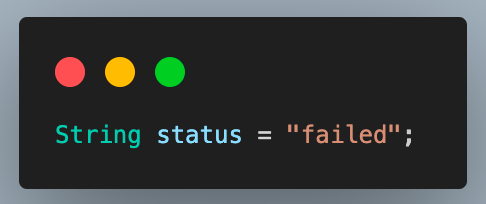 1. Update the code inside the *setup()* method to set the required browser properties and LambdaTest configurations to connect to the cloud grid. 2. Create an object of the *ChromeOptions *class and set the OS and browser versions. 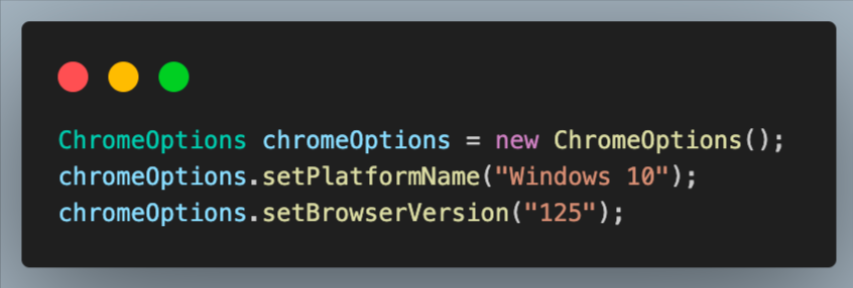 1. Next, create a *HashMap* type variable to specify the additional browser capabilities for the LambdaTest platform. This will help to identify the dashboard test results using the build name and other details.  You can fetch the required browser capabilities from the LambdaTest platform by navigating to the [Automation Capabilities Generator](https://www.lambdatest.com/capabilities-generator/). This helps by offering ready-to-use code for setting up browser capabilities that can be used in execution. 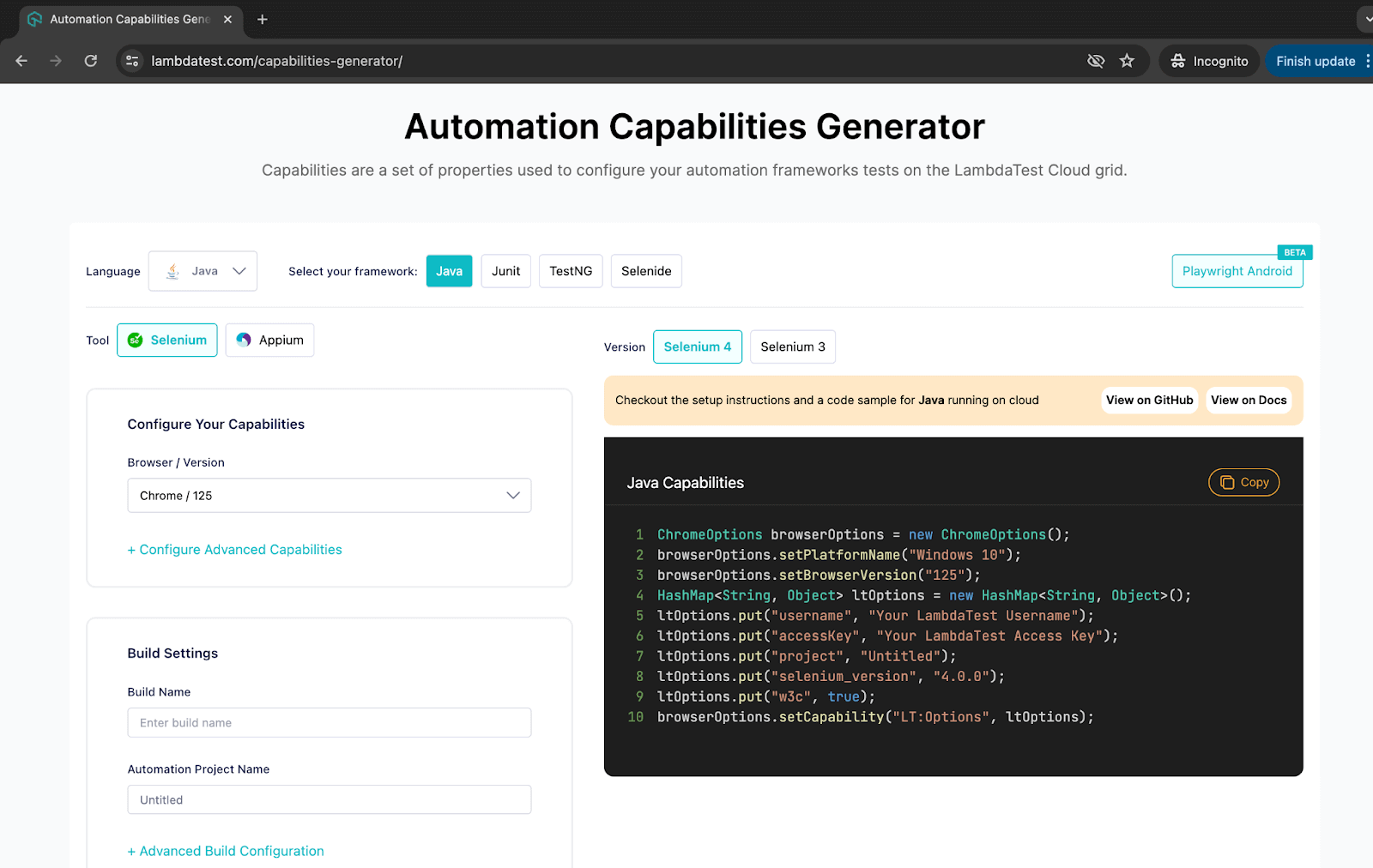 1. Finally, use the Selenium *RemoteWebDriver* to connect to the LambdaTest remote grid using your credentials and *ChromeOptions* class object containing all specified browser capabilities.  1. Use this driver to navigate the Two Input Fields page on the LambdaTest Selenium Playground for test execution.  1. Inside the *tearDown()* method, add a step to execute the script to update the test case status on the LambdaTest dashboard.  1. Next, move to the test class TwoInputFieldTests.java and add the step to update the status to *passed *after the execution of all test cases. 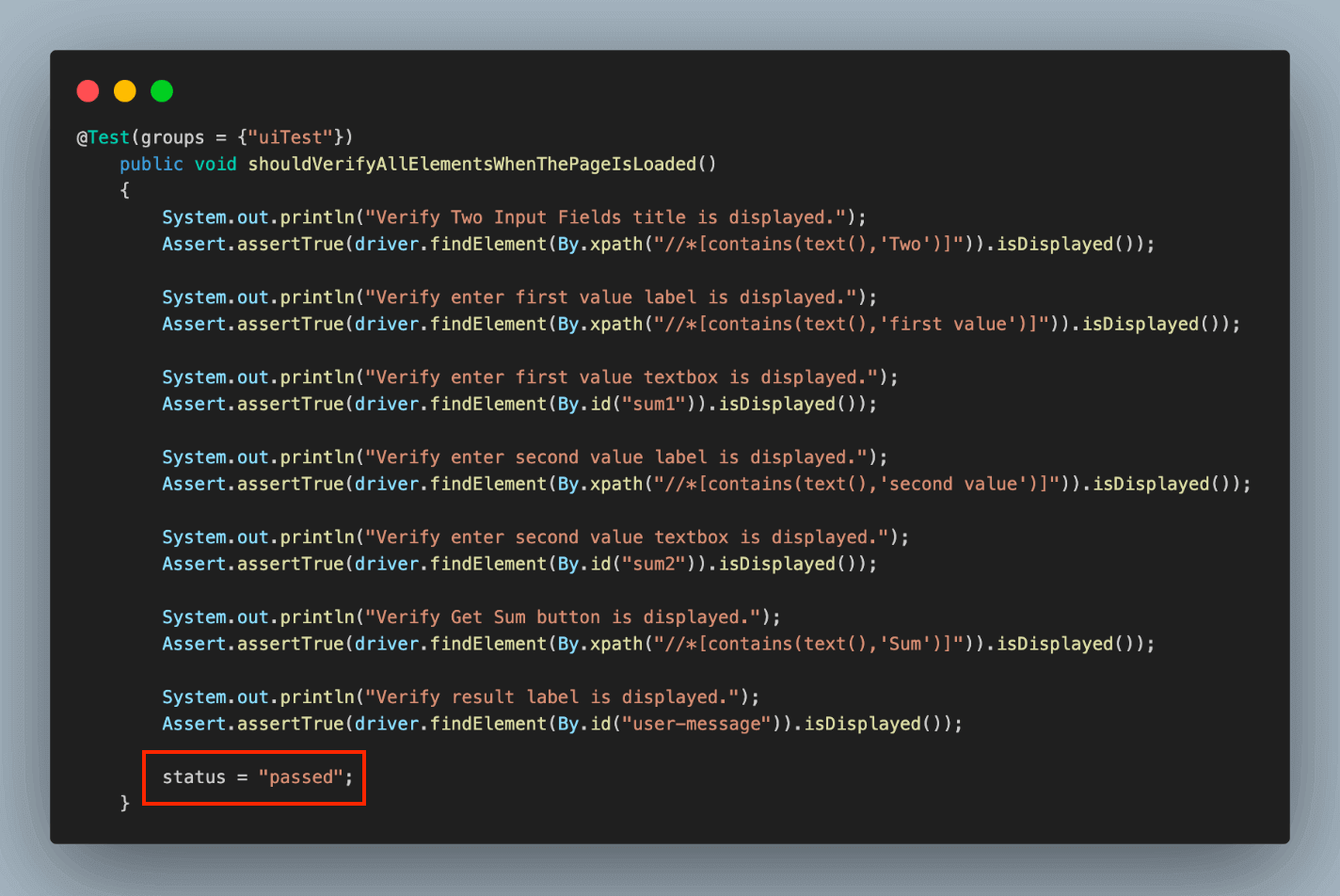 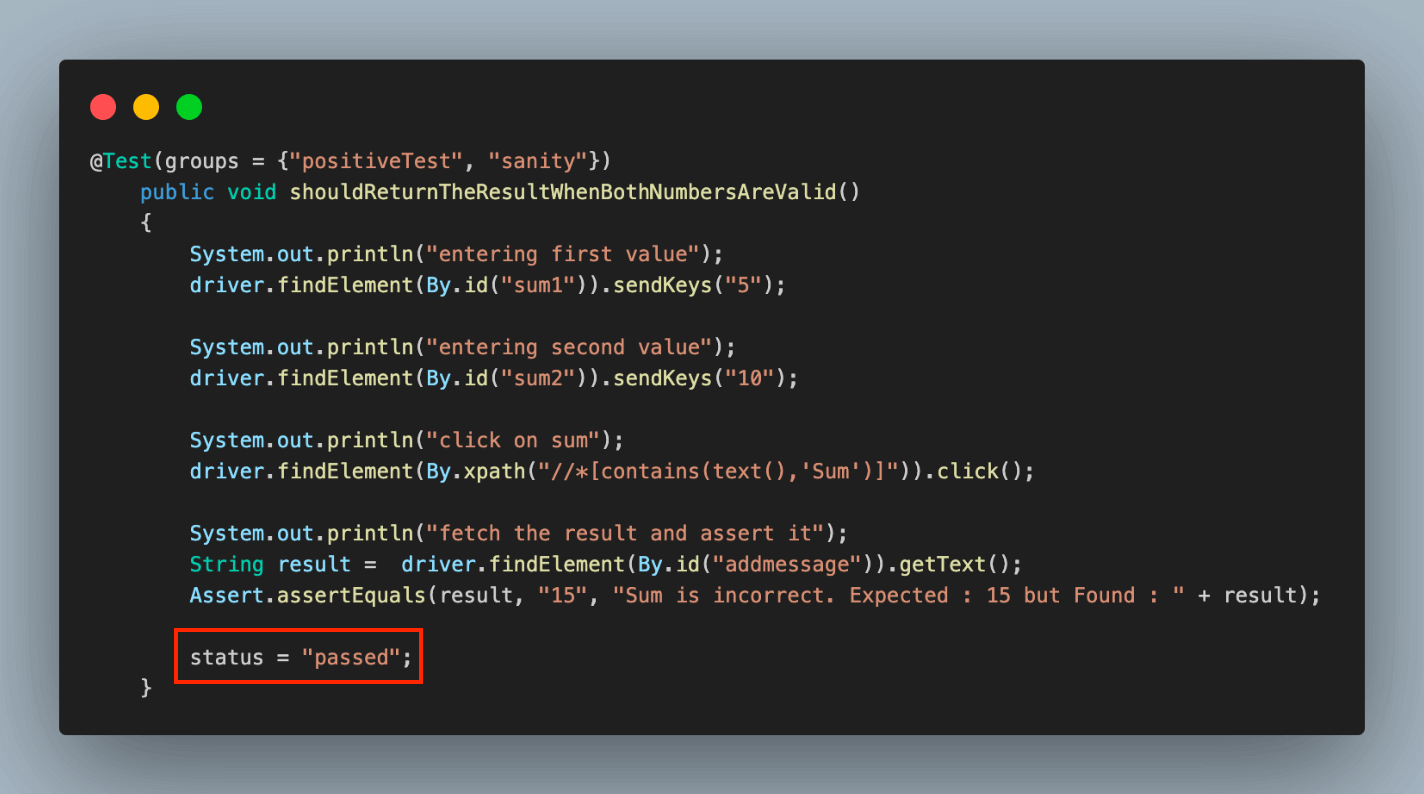 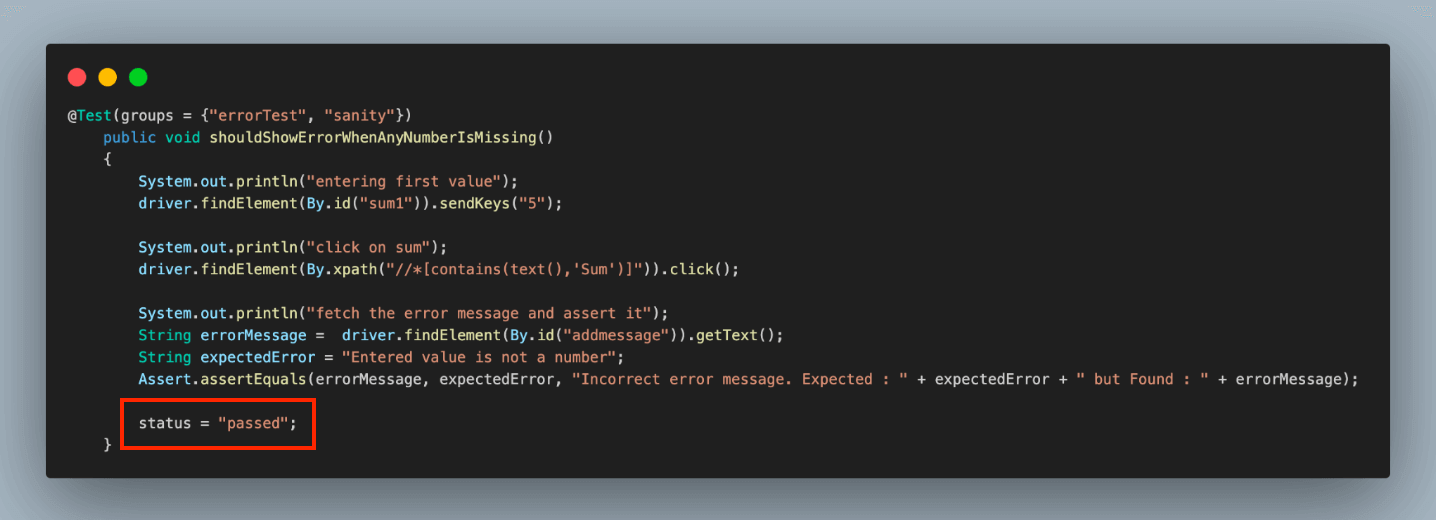 **Results:** We can execute the test cases similarly to how we did for local execution. The console output in the IDE will remain unchanged, but the primary focus will shift to monitoring the execution results on the LambdaTest dashboard. The execution results are on the LambdaTest Dashboard under the **Automation > Web Automation** tab. 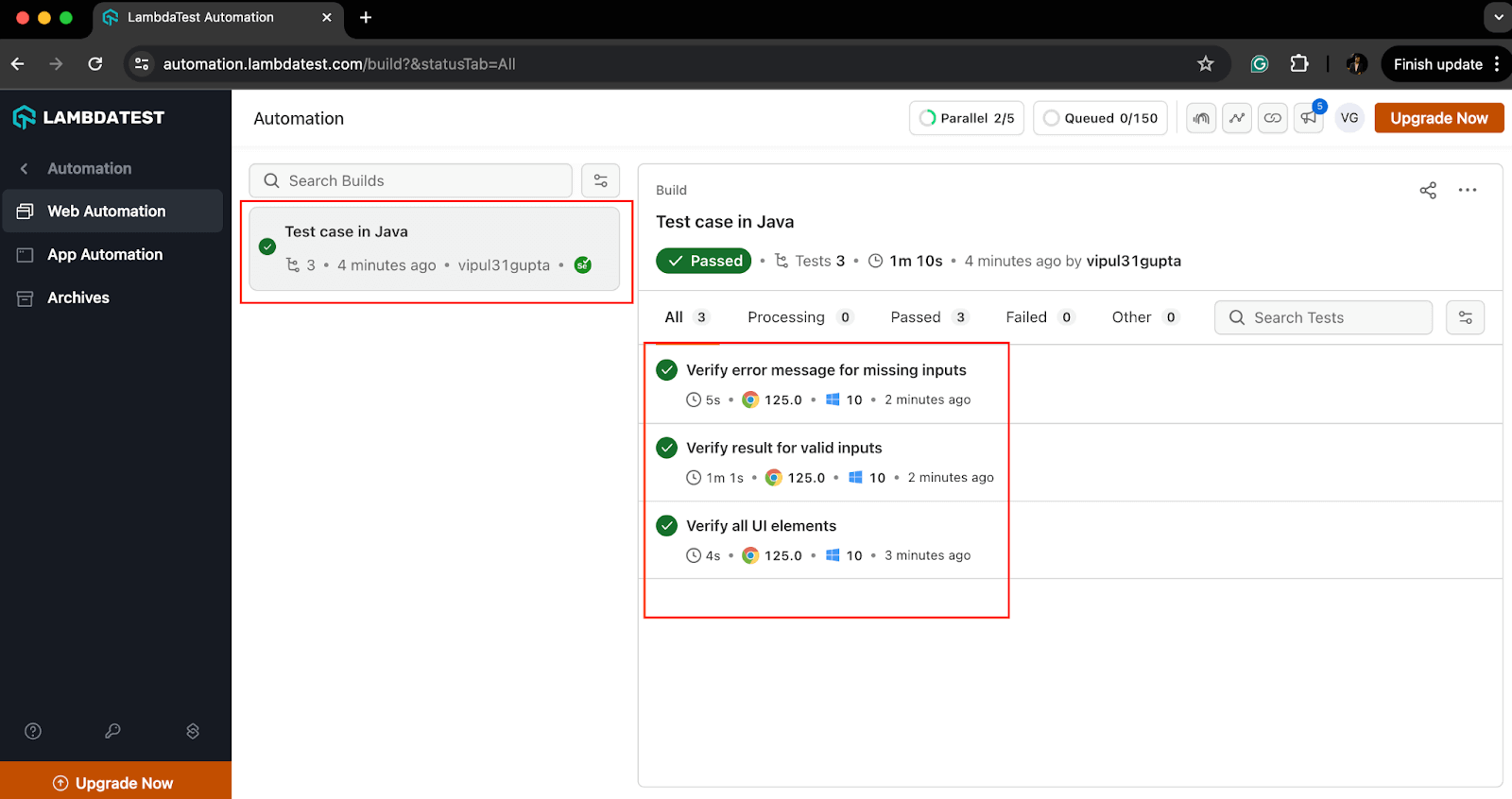 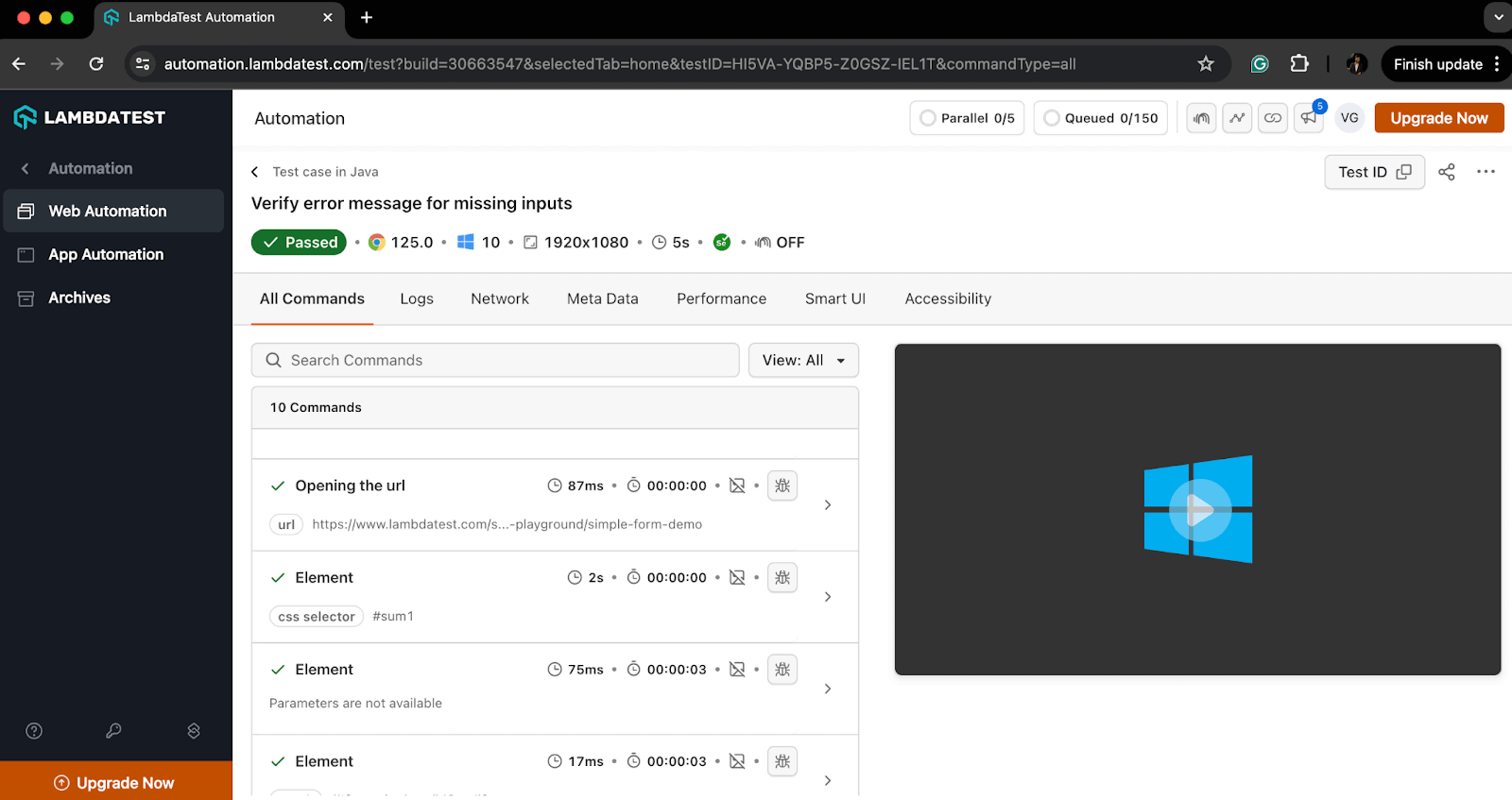 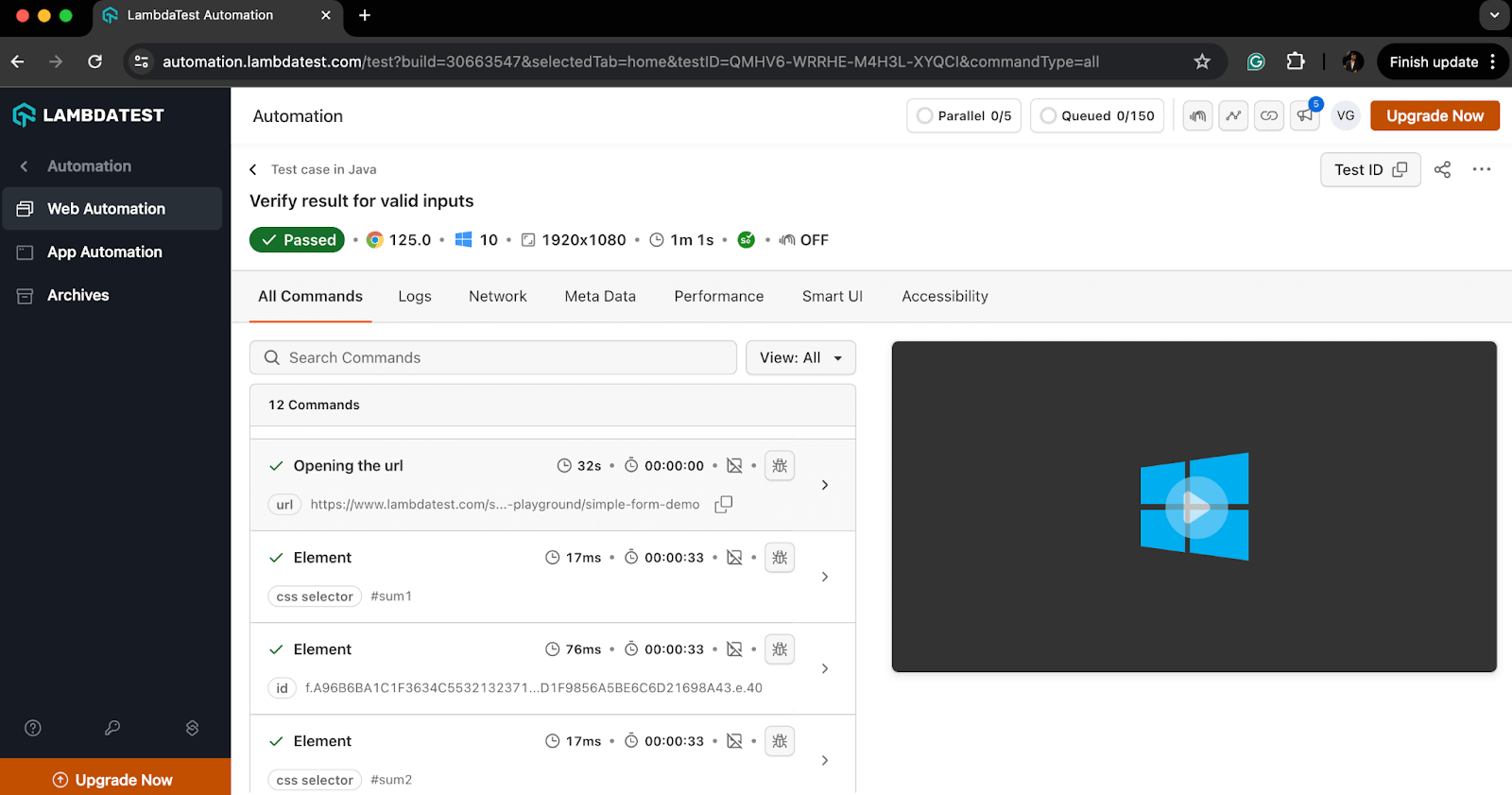 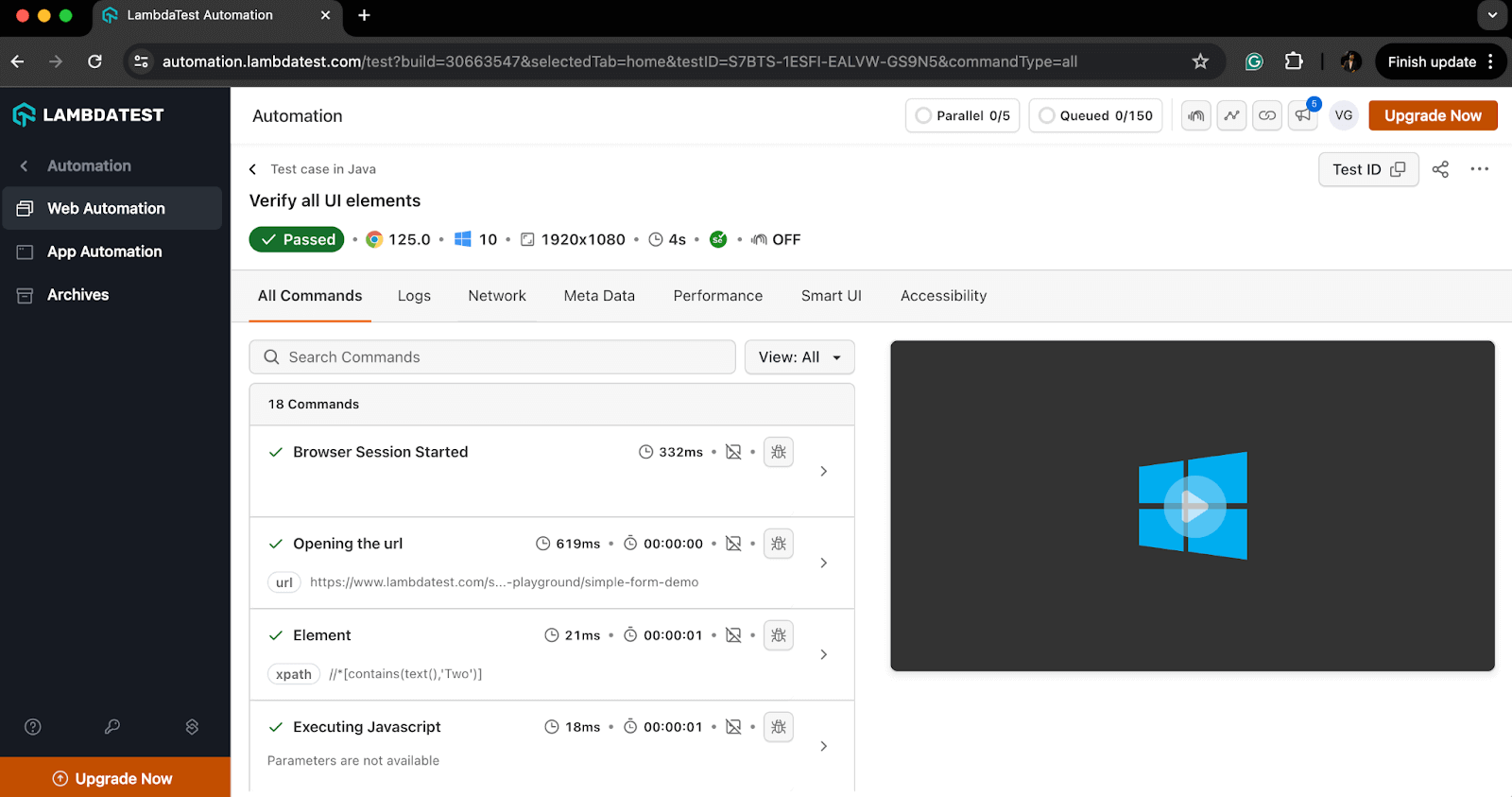 ## Best Practices for Writing Test Cases in Java All the test executions we’ve learned above are written following best practices. Adhering to these practices helps avoid repeating the same or similar mistakes and ensures a smooth test flow in your automation projects. Some of the best practices are given below. * **Understanding the Requirements** The first and foremost requirement of writing a good test case is understanding the changes and features clearly. The tester needs to know what is expected from the code based on the input. We can refer to the product requirement documentation or the acceptance cases to know the expected behavior. * **Maintainable and Reusable Code** The test cases should be readable and follow clean coding principles. This helps to keep test cases maintainable and allows quick refactoring in case of requirement changes without much hassle. * **Clear and Descriptive Test Case Names** The names should be clear and meaningful so that anyone who sees the code or test case can understand what a particular test is supposed to do. The name should be descriptive enough to describe the purpose of the test case. One of the naming conventions one can follow is *should[ExpectedResult*]*When[Condition]*. For example, *shouldReturnTheResultWhenBothNumbersAreValid *or *shouldShowErrorWhenAnyNumberIsMissing*. * **Arrange-Act-Assert Structure** Try to follow the AAA structure for your test cases for effective test management by splitting it into three parts. * **Arrange:** Define and set up the test environment and test data on which we want to execute the test. * **Act:** Write the execution steps which interact with the feature using the above data. * **Assert:** Write proper assertions which verify the actual and expected results. * **One Test Case, One Assertion** Use specific and meaningful assertions for each test case, which helps to verify the required details. One test should not be used to verify multiple flows and should not have a dependency on any other test case. For example, valid results for valid input and error responses for invalid input should be two separate test cases. You can use assertions like *assertEquals(), assertTrue(), assertFalse(), assertNotNull()*, etc., to assert to-the-point data and provide meaningful messages to better understand the failures. * **Using Setup and Teardown Methods** Use *@Before* and *@After* annotations of JUnit or TestNG, depending on your framework, to write setup and teardown methods. These methods help to prevent duplicity by making the common code, like driver setup, browser launch, driver termination, etc, reusable across all the test cases. * **Using Mock Data and Stubs for Error Cases** Mock data or stubs means to simulate a function behavior in the software to return some particular result as desired by the tester to test some particular test cases. We can use mocking frameworks like Mockito or write a stub function to mock dependencies and verify test cases for external dependency failures. * **Covering Edge and Boundary Value Cases** Write test cases to cover all the edge cases or unusual scenarios due to software or hardware downtimes. You can use mocking for such types of test cases. Also, testing for boundary values by passing various test data helps verify if the code and software function properly for limiting cases. * **Using Tags, Groups, and Categories** Use tags, groups, or categories to group the related test cases together that serve some common purpose, flow, or requirement in general. For instance, you can group all test cases for login flow, positive and negative cases, etc. ## Conclusion With this, we have concluded this blog on how to write a test case in Java. In this blog, we learned how a good test case can be written with a basic understanding of Java language and test case fundamentals like flow, assertions, and WeElement locators. We learned the working examples on local and cloud grids and understood how following the best practices makes the test case robust and reliable. Now, it’s time for you to go ahead and try writing your first [test case](https://www.lambdatest.com/learning-hub/test-case?utm_source=medium&utm_medium=organic&utm_campaign=aug_12&utm_term=rj&utm_content=blog) in Java. Happy learning!!
Atas ialah kandungan terperinci Cara Menulis Kes Ujian dalam Java. Untuk maklumat lanjut, sila ikut artikel berkaitan lain di laman web China PHP!
 Apakah maksud vram?
Apakah maksud vram?
 Indeks melebihi penyelesaian sempadan tatasusunan
Indeks melebihi penyelesaian sempadan tatasusunan
 pycharm membuka kaedah fail baharu
pycharm membuka kaedah fail baharu
 Cara menggunakan marginwidth
Cara menggunakan marginwidth
 Perbezaan antara ms office dan wps office
Perbezaan antara ms office dan wps office
 Bagaimana untuk menyelesaikan kod kacau securecrt
Bagaimana untuk menyelesaikan kod kacau securecrt
 Apakah maksud bunyi gesaan Douyin sw?
Apakah maksud bunyi gesaan Douyin sw?
 Bagaimana untuk membayar balik Douyin yang dicas semula Doucoin
Bagaimana untuk membayar balik Douyin yang dicas semula Doucoin




